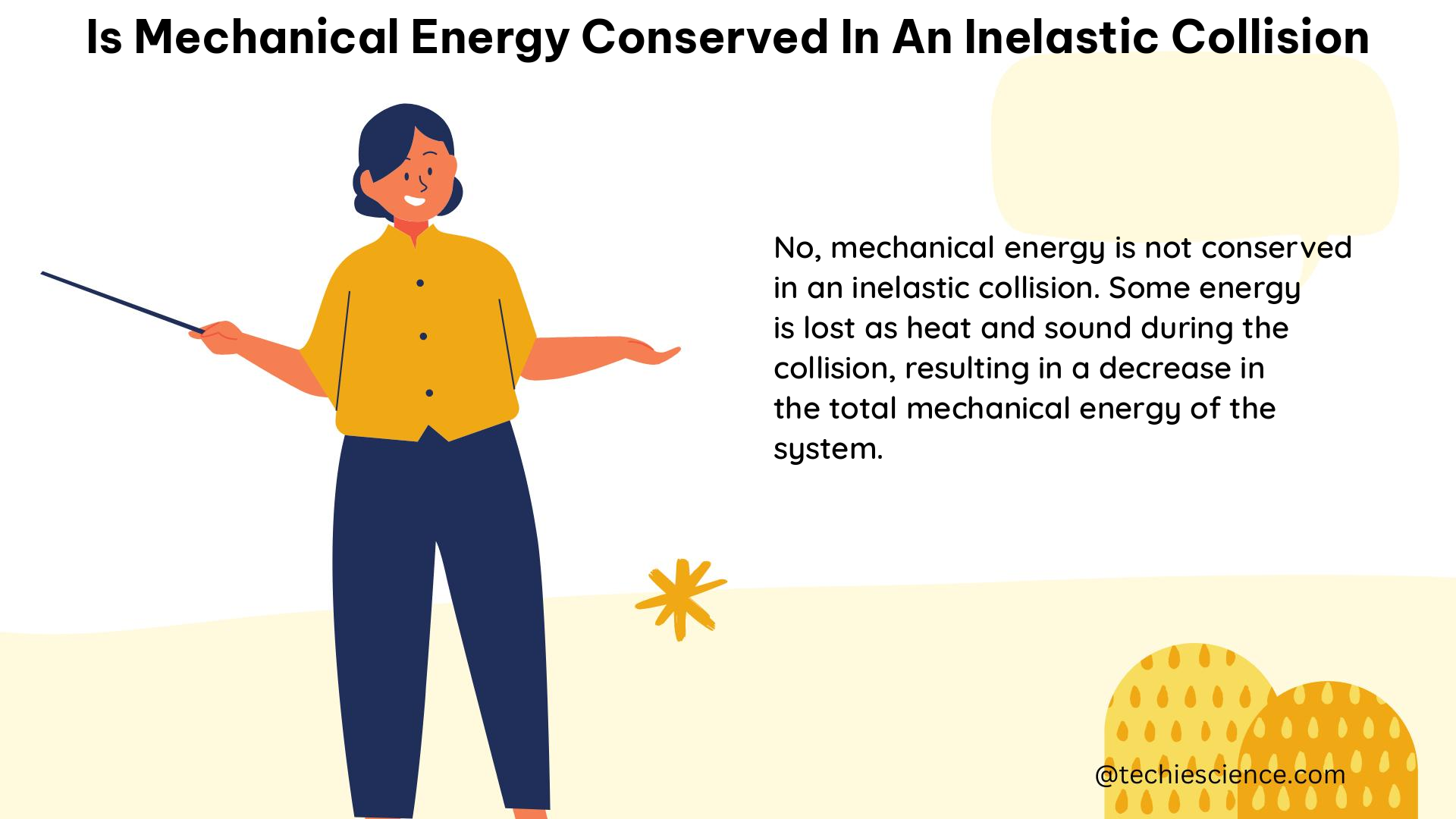In the realm of physics, understanding the conservation of mechanical energy is crucial, especially when it comes to the analysis of inelastic collisions. Mechanical energy, which is the sum of kinetic energy and potential energy, is not conserved in an inelastic collision. Instead, a portion of the kinetic energy is converted into other forms of energy, such as heat, sound, and deformation energy.
Momentum Conservation in Inelastic Collisions
One of the fundamental principles in physics is the conservation of momentum. This principle holds true for both elastic and inelastic collisions. In an inelastic collision, the total momentum before the collision is equal to the total momentum after the collision. This means that the sum of the momenta of the colliding objects remains constant, even though the kinetic energy may not be conserved.
The mathematical expression for the conservation of momentum in an inelastic collision is:
m1v1 + m2v2 = m1v'1 + m2v'2
Where:
– m1 and m2 are the masses of the colliding objects
– v1 and v2 are the initial velocities of the colliding objects
– v'1 and v'2 are the final velocities of the colliding objects after the collision
Kinetic Energy Loss in Inelastic Collisions

In an inelastic collision, some of the kinetic energy is lost and converted into other forms of energy. This results in a decrease in the total kinetic energy after the collision. The amount of kinetic energy lost depends on the nature of the collision and the properties of the colliding objects.
The mathematical expression for the kinetic energy lost in an inelastic collision is:
ΔKE = KE_before - KE_after
Where:
– ΔKE is the change in kinetic energy
– KE_before is the total kinetic energy before the collision
– KE_after is the total kinetic energy after the collision
Energy Transformation in Inelastic Collisions
The lost kinetic energy in an inelastic collision is transformed into other forms of energy, such as heat, sound, and deformation energy. These forms of energy are not considered mechanical energy, as they are not directly related to the motion or position of the objects.
The conversion of kinetic energy into these other forms of energy is due to the internal forces within the colliding objects, such as friction and deformation. These internal forces cause the objects to deform, vibrate, and generate heat, which are not easily recoverable for mechanical purposes.
Perfectly Inelastic Collisions
In a perfectly inelastic collision, the maximum possible kinetic energy is lost, and the colliding objects stick together, moving with a shared velocity after the collision. This type of collision represents the scenario where the objects undergo the greatest deformation and energy transformation.
The mathematical expression for the final velocity of the combined objects in a perfectly inelastic collision is:
v' = (m1v1 + m2v2) / (m1 + m2)
Where:
– v' is the final velocity of the combined objects
– m1 and m2 are the masses of the colliding objects
– v1 and v2 are the initial velocities of the colliding objects
Examples and Numerical Problems
- Energy Loss Example:
- In a head-on collision between two vehicles, the kinetic energy before the collision is 100 J.
- After the collision, the kinetic energy is reduced to 60 J.
-
The lost energy (40 J) is converted into heat and sound.
-
Momentum Conservation Example:
- Two objects with masses 2 kg and 3 kg collide inelastically.
- Before the collision, the total momentum is 10 kg m/s.
-
After the collision, the total momentum remains 10 kg m/s, but the kinetic energy is reduced.
-
Numerical Problem:
- Two objects with masses 5 kg and 3 kg are moving with initial velocities of 4 m/s and 2 m/s, respectively, in the same direction.
- They collide inelastically, and the final velocity of the combined objects is 3 m/s.
- Calculate the change in kinetic energy due to the inelastic collision.
Given:
– m1 = 5 kg, m2 = 3 kg
– v1 = 4 m/s, v2 = 2 m/s
– v' = 3 m/s
Step 1: Calculate the initial kinetic energy.
Initial kinetic energy = (1/2) * m1 * v1^2 + (1/2) * m2 * v2^2
Initial kinetic energy = (1/2) * 5 * 4^2 + (1/2) * 3 * 2^2 = 40 J + 6 J = 46 J
Step 2: Calculate the final kinetic energy.
Final kinetic energy = (1/2) * (m1 + m2) * v'^2
Final kinetic energy = (1/2) * (5 + 3) * 3^2 = 24 J
Step 3: Calculate the change in kinetic energy.
Change in kinetic energy = Initial kinetic energy – Final kinetic energy
Change in kinetic energy = 46 J – 24 J = 22 J
The change in kinetic energy due to the inelastic collision is a decrease of 22 J.
Conclusion
In summary, mechanical energy is not conserved in an inelastic collision. While momentum is always conserved, a portion of the kinetic energy is lost and converted into other forms of energy, such as heat, sound, and deformation energy. This loss of kinetic energy is a key characteristic of inelastic collisions and is an important concept in the study of physics.
Reference:
- https://www.coursehero.com/file/26596054/Lab-09-Momentum-and-Energypdf/
- https://www.youtube.com/watch?v=9hJm3ym3EN4
- https://www.khanacademy.org/science/physics/linear-momentum/elastic-and-inelastic-collisions/a/what-are-elastic-and-inelastic-collisions
- https://www.physicsclassroom.com/class/energy/Lesson-2/Analysis-of-Situations-in-Which-Mechanical-Energy
- https://physics.stackexchange.com/questions/402117/when-is-mechanical-energy-ever-conserved-for-inelastic-collisions
Hi ….I am Abhishek Khambhata, have pursued B. Tech in Mechanical Engineering. Throughout four years of my engineering, I have designed and flown unmanned aerial vehicles. My forte is fluid mechanics and thermal engineering. My fourth-year project was based on the performance enhancement of unmanned aerial vehicles using solar technology. I would like to connect with like-minded people.